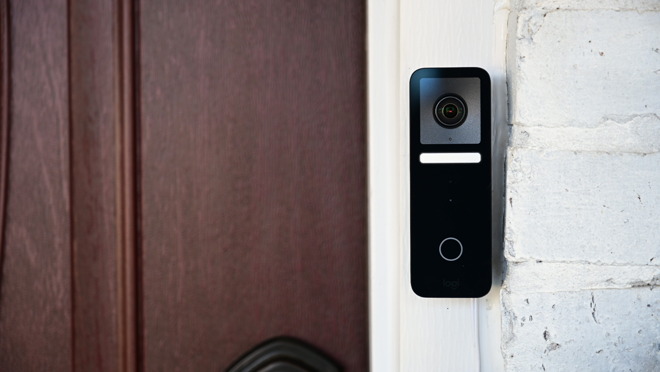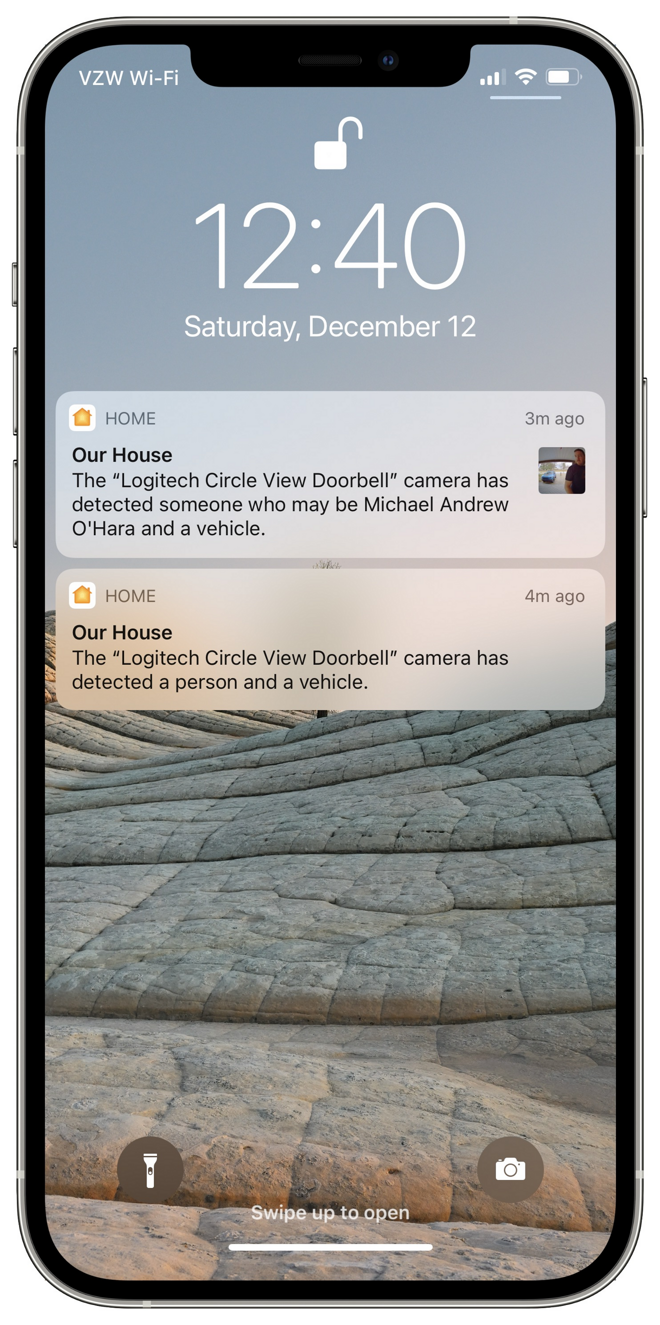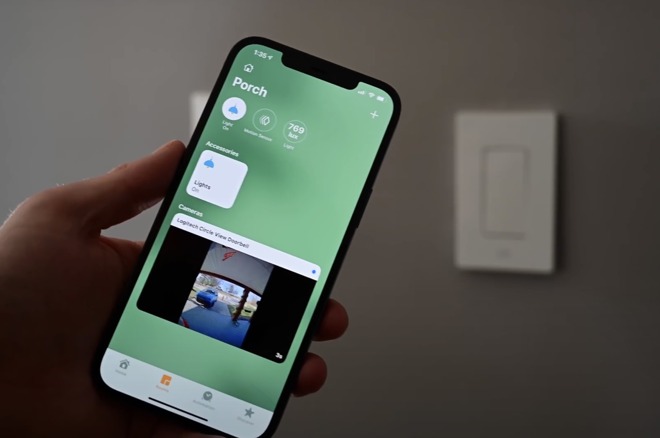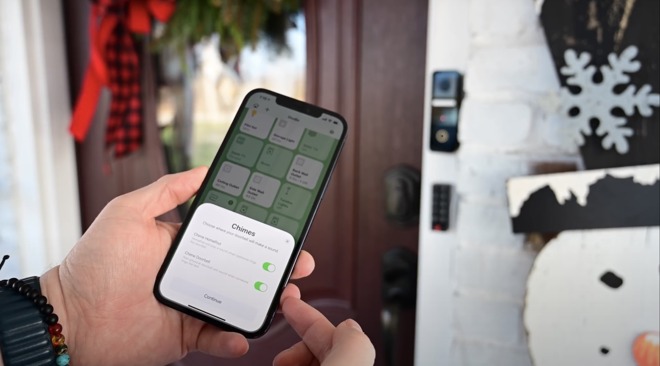HomeKit isn't ready yet for your front door
Smart video doorbells equipped with HomeKit Secure Video are just now starting to hit the market. While they offer many great features and deep integration into Apple's smart home platform, they are still plagued by inadequacies.

Logitech Circle View Wired Doorbell
HomeKit Secure Video was a bold move for HomeKit. It became the first HomeKit feature that cost users money, requiring users to pay $2.99 or $9.99 for either 200GB or 2TB of storage, enabling up to five cameras to record ten days of footage to iCloud. Users weren't required to use any third-party apps or rely on any third-party cloud servers. This inherently made putting cameras in your home more secure and less risky.
Apple made it even better by adding the much-requested ability to add zones as well as facial recognition to HomeKit cameras. These went a long way towards improving HomeKit's video capabilities and making them on-par with other offerings flooding the market.
I appreciate HomeKit Secure Video and have relied on it consistently inside my home. But, it falls significantly short of being ready to serve as the brains of a video doorbell.
I've tested many HomeKit devices, but the HomeKit Secure Video Doorbell category has been slim. The Robin ProLine and Robin ProLine Compact support HomeKit Secure Video but are very expensive. Netatmo has long-promised HSV but has yet to roll the feature out to its video doorbell that supports vanilla HomeKit.
Logitech's announcement of its Circle View Wired Doorbell was a big deal in the HomeKit space and I, like many, rushed to pick one up. After living with it for the past week, it is clear while Logitech's hardware is top-notch, there is much work for Apple to do in the HomeKit space.
Upon first setting up my HomeKit Secure Video Doorbell, I almost immediately was inundated with notifications. They came in repeatedly and quickly, without pause. This is the default state and, in practice, was near unusable as lights, leaves, tree branches, and ribbons from Christmas decorations continued to trip the motion sensor.

Alerts from a HomeKit Secure Video doorbell
To make the barrage more manageable, I used HomeKit's abilities to only allow specific notifications. I tailored them only to show when a person or car is detected. This still yields excessive alerts for me. What happens is because my car is parked in front of my door, some errant motion would trip the sensor. Then the AI video analysis done on my Home Hub determines that there is a car in the frame, and thus I get alerted that a vehicle was detected-- even though it's mine, and it never moved.
The AI still has work to do as well when it comes to person detection. Too often has my doorbell notified me that a "person" was at the door when there was no one around. Somehow a minute amount of background motion trips the camera, and HomeKit's analysis identifies a person, despite the lack of one.
While sometimes I got alerts there was a person when there wasn't, I also had the inverse happen.

A HomeKit video doorbell in the Home app
There have been times where I found a package on my porch, and yet there was no recording of the delivery driver bringing it up or a notification. Somehow the AI decided that it wasn't a person carrying the package and thus didn't alert me or record any video. This is disconcerting for a device that is supposed to be protecting my home.
A small amount of this is due to early hardware. In particular, Logitech uses video analysis to detect motion, which isn't as accurate as a PiR sensor, which can have its sensitivity adjusted. A PiR sensor is more accurate than video analysis at detecting motion and could save some of the hassles I've been experiencing, but only a small amount.
Even with a PiR sensor for detecting motion, it still doesn't alleviate the issues with Apple's erratic notifications and inconsistent video analysis done by your Home Hub.

HomeKit is still fantastic, and doorbells have many benefits including chiming on HomePod
There are a ton of benefits to a HomeKit doorbell. The ability to ring your HomePods and appear on your Apple TV is amazing, and any other smart doorbell can't do this. And then, there's the integration with other HomeKit accessories such as lights or door locks.
Even with the issues outlined above, I still find it worth having a HomeKit Secure Video doorbell. I do have the ability to put up with more problems than your average user does or should have to.
While I'm sticking with it, HomeKit isn't ready for your own front door today. Here's hoping Apple has some improvements in store for 2021.

Logitech Circle View Wired Doorbell
HomeKit Secure Video was a bold move for HomeKit. It became the first HomeKit feature that cost users money, requiring users to pay $2.99 or $9.99 for either 200GB or 2TB of storage, enabling up to five cameras to record ten days of footage to iCloud. Users weren't required to use any third-party apps or rely on any third-party cloud servers. This inherently made putting cameras in your home more secure and less risky.
Apple made it even better by adding the much-requested ability to add zones as well as facial recognition to HomeKit cameras. These went a long way towards improving HomeKit's video capabilities and making them on-par with other offerings flooding the market.
I appreciate HomeKit Secure Video and have relied on it consistently inside my home. But, it falls significantly short of being ready to serve as the brains of a video doorbell.
I've tested many HomeKit devices, but the HomeKit Secure Video Doorbell category has been slim. The Robin ProLine and Robin ProLine Compact support HomeKit Secure Video but are very expensive. Netatmo has long-promised HSV but has yet to roll the feature out to its video doorbell that supports vanilla HomeKit.
Logitech's announcement of its Circle View Wired Doorbell was a big deal in the HomeKit space and I, like many, rushed to pick one up. After living with it for the past week, it is clear while Logitech's hardware is top-notch, there is much work for Apple to do in the HomeKit space.
Real world time with a HomeKit Secure Video doorbell
Notifications couldn't be more crucial on a camera at the entrance to your home. They alert you to visitors, packages, or uninvited intruders. Too few, you miss things. Too many, you stop looking at them.Upon first setting up my HomeKit Secure Video Doorbell, I almost immediately was inundated with notifications. They came in repeatedly and quickly, without pause. This is the default state and, in practice, was near unusable as lights, leaves, tree branches, and ribbons from Christmas decorations continued to trip the motion sensor.

Alerts from a HomeKit Secure Video doorbell
To make the barrage more manageable, I used HomeKit's abilities to only allow specific notifications. I tailored them only to show when a person or car is detected. This still yields excessive alerts for me. What happens is because my car is parked in front of my door, some errant motion would trip the sensor. Then the AI video analysis done on my Home Hub determines that there is a car in the frame, and thus I get alerted that a vehicle was detected-- even though it's mine, and it never moved.
The AI still has work to do as well when it comes to person detection. Too often has my doorbell notified me that a "person" was at the door when there was no one around. Somehow a minute amount of background motion trips the camera, and HomeKit's analysis identifies a person, despite the lack of one.
While sometimes I got alerts there was a person when there wasn't, I also had the inverse happen.

A HomeKit video doorbell in the Home app
There have been times where I found a package on my porch, and yet there was no recording of the delivery driver bringing it up or a notification. Somehow the AI decided that it wasn't a person carrying the package and thus didn't alert me or record any video. This is disconcerting for a device that is supposed to be protecting my home.
A small amount of this is due to early hardware. In particular, Logitech uses video analysis to detect motion, which isn't as accurate as a PiR sensor, which can have its sensitivity adjusted. A PiR sensor is more accurate than video analysis at detecting motion and could save some of the hassles I've been experiencing, but only a small amount.
Even with a PiR sensor for detecting motion, it still doesn't alleviate the issues with Apple's erratic notifications and inconsistent video analysis done by your Home Hub.
Maybe 2021
I hate to be pessimistic as HomeKit has made giant leaps in 2020. We saw significant enhancements to HomeKit video, HomeKit Secure Video doorbells launched, we got our first two HomeKit air purifiers, Apple launched Adaptive Lighting, we saw the launch of Thread on HomeKit and more.
HomeKit is still fantastic, and doorbells have many benefits including chiming on HomePod
There are a ton of benefits to a HomeKit doorbell. The ability to ring your HomePods and appear on your Apple TV is amazing, and any other smart doorbell can't do this. And then, there's the integration with other HomeKit accessories such as lights or door locks.
Even with the issues outlined above, I still find it worth having a HomeKit Secure Video doorbell. I do have the ability to put up with more problems than your average user does or should have to.
While I'm sticking with it, HomeKit isn't ready for your own front door today. Here's hoping Apple has some improvements in store for 2021.


Comments
That probably means Netatmo is also having these problems with HSV. As a result, they haven’t rolled it out.
Update: Another bug to mention. It allows chime to HomePod - but fails for me. Prolly as my two HomePods are Stereo Pair.. but still. Bug
Ring cameras have a very extensive set of options for setting up detection zones, detection sensitivity, people-only detection, detection schedules, detection snooze, night vision, through-window capability on some cameras, recording snapshot frequency (max once every 30 sec) and duration, attaching snaphots to notifications, device linking, etc. Frankly, the feature set for Ring cameras and the Ring Alarm system ($100/year with unlimited camera uploads with 60 day history, professional monitoring) is amazing. As a bonus, most Alexa devices (including the lowly Dot) also function as glass breakage detectors and smoke/CO alarm listeners when in Away mode.
This is not a plug for Amazon/Ring, it's simply a reminder that Apple HomeKit has a lot of catching up to do on the functionality side and with broader device support. The performance and security of Z-Wave Plus that Ring uses is excellent as is the responsiveness of Alexa, in general, and its interaction with smart devices like smart plugs and lighting. I swapped my kitchen HomePod with an Echo Studio (moved the HomePod to a different room to serve as a sound bar) and the improvement in response time to my queries going from Siri to Alexa is extremely noticeable, even for Apple Music related queries. Yeah, HomePod sounds better but Siri is, how do I say this, a "little slow."
So what are the vulnerabilities in the well rounded systems like Amazon-Ring that Apple can exploit? The number one thing that comes to mind is the latency between camera detection (motion or button press) and video availability. With Ring, everything goes up to the cloud first, before being available for viewing on any device. All of my Ring cameras are PoE powered and connected to gigabit Ethernet, but my upload speed is mediocre so there is still a noticeable delay between getting a motion notification or button press and seeing what's there. Download performance is great.
Ring has a performance optimized companion viewer app called Rapid Ring that is definitely faster than their main app, but it still has some latency. The ideal situation for me would be to allow simultaneous live streaming over the same local network for at least one camera while also pumping the video up to the cloud for archival purposes. This feature would be a game changer. Yeah, I can put together my own local camera capture and recording system but integration of all of these smart devices, sensors, cameras, etc., around a cloud based ecosystem brings so many benefits to bear, and also some risks, that I would be hard pressed to give up after having used them so successfully for so long.
I know what I'm going to say next may sound radical to some folks, but I wouldn't say if I hadn't already taken part in such a move that was highly successful. Apple should consider spinning off HomeKit into an independent consortium or association of smart home vendors, of which Apple would remain an executive member of the leadership council. This is akin to what they've done with the Swift programming language. The success of HomeKit is based on its widespread adoption, and Apple isn't really contributing enough organically and uptake by third parties is too slow. Moving HomeKit outside of Apple would provide third parties with more incentive to put more skin in the game because they are helping to steer the ship. Apple, as an executive board member would still provide stewardship over the technology core and ensure that the tenets that are so important to Apple, like security and privacy, are never compromised. And just to be clear, I'm talking about moving HomeKit outside of Apple, physically and legally, not simply having Apple invite third parties to participate in Apple's gig like they do with developers and partners.
That said, Netatmo can still be better because you can turn off HomeKit notifications, let HomeKit still record, and rely on the Netatmo app for notifications. That could yield better results because it is doing the analysis, not HomeKit.
This is the workflow for HomeKit. The doorbell constantly is scanning the video and whenever motion is detected, it sends a frame to the Home Hub to analyze it to see what is in the frame and if it is the activity zone. If there is motion in the zone and it fits with whatever filters you have on, it sends you the notification. The only thing the camera does is scan for the motion.
- Sends too many errant notifications
- Misses obvious motion such as a person walking to your door
- Misidentifies detected motion which can cause notifications to accidentally show or not show depending on your settings
- Isn’t able to differentiate packages
- iCloud limits you to 5 cameras
Honestly, the fact that a security camera can completely miss a person walking to your front door is reason enough to “not be ready” but the remaining four reasons reinforce that handily. It is a security camera so it doesn’t do all that many things, but it needs to do them well. I’m not sure what other reasons there could possibly be.
As it stands, it is only a default chime sound. You can choose which HomePods ring, but you can’t change the tone. it is definitely an Apple tone though and not a common one.
Totally agree that others are ahead of the game here, including Ring.
As far as the independent group, Apple is somewhat doing that. They are working with others on a smart home consortium in developing a standard for smart home devices which should enable faster development and easier deployment across multiple platforms. This gives Apple a say in how everything communicates but also still allows them full control over HomeKit so that it can be built deeply into iOS. It is the deep roots in the Apple ecosystem that makes HomeKit so incredible to use. The doorbell showing on the Apple TV and chiming on HomePod are a good example of that.
I value HK because I trust Apple to do the right thing by me. I don’t feel the same way about the the other companies.
Never misses a human. Notifications are completely customizable. Works seamlessly in my roughly 100 device homekit environment.
Then again, I have a garage, so my vehicle isn't parked on video permanently.
The only criticism I can agree with is the 5 camera ICloud limit.